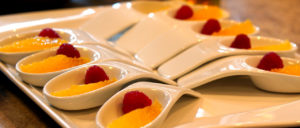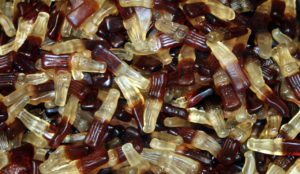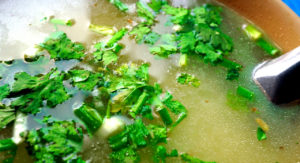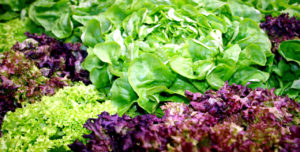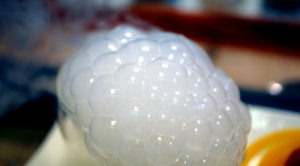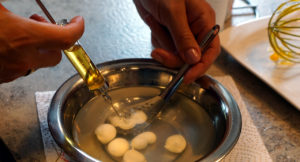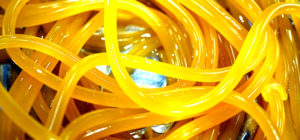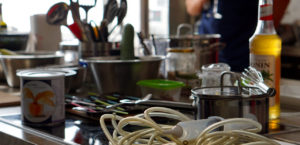A prerequisite for experiencing a culinary firework display – as well as the rat Rémy does in the legendary animated film Ratatouille knew how to make his brother Emile experience it – is the sense of taste and smell.
Of the classical senses such as hearing, seeing, smelling, tasting and touching, smelling – olfactory perception – remains by far the most important and strongest of our senses.
Only the sense of smell is able to flood us in milliseconds with images from days long gone by at the slightest hint of a familiar scent – from the school canteen, or the aunt who used “that one perfume” many years ago. We can smell when it is Christmas – not only cinnamon & cardamom, but also the classic Christmas meal comes to mind when red cabbage is prepared.
Of course, not all olfactory memories are positive – but that’s how it has to be, because our sense of smell also serves to protect us from harm.
Without this sense, in which the circulation of aromas through the air we breathe along the olfactory buds or olfactory cells enables us to distinguish odours, it becomes difficult to taste.
Everybody knows the effect that food tastes different or hardly at all when we have a cold, for example – try an espresso and keep your nose closed while trying it – the espresso will taste much less intense.
Let’s get from smelling to tasting – basically the human tongue is able to distinguish several flavours. For this purpose, the taste buds are used – a good hundred taste buds come on a “bud” – they are each specialized in one of the following six flavours, whereby “fatty” is not counted in many places. In 2005, the French scientist Philippe Besnard claimed to have identified receptors for fatty acids.
- Salty (detects different salts)
- Sour (warns against the immature, inedible & spoiled)
- Sweet (detects different sugar variants & sweeteners)
- Bitter (warns of poisons, inedible & spoiled things)
- Umami (recognizes tasty, proteins, etc.)
- Fatty (recognizes energy rich)
Even “hot” is not one of the classic flavours, because here in the mouth and throat area the receptors for heat & pain are addressed – not the taste buds.
The outdated idea that only the tongue is able to perceive flavours, and only in special areas, is based on research results from 1901.
At that time the physiologist David Pauli Hänig had published his idea of the distribution and location of human taste receptors in the form of a “tongue map”. This was used for decades in schools, universities or by doctors, but has long been disproved.
Nevertheless, this myth still persists – not least because there are still thousands of corresponding optical interpretations of the “tongue map” on the Internet.
The taste buds are not only found on our tongue – especially to the sides and back – they are found throughout the throat, on the palate and soft palate as well as on the larynx and upper esophagus. The distribution of the taste buds – especially on the tongue – enables us to perceive almost all flavours everywhere on the tongue. We perceive sweet especially at the front edge and the sides – and bitter rather at the back, but otherwise quite even.
The only exception is Umami – Umami (translated, intense, spicy, meaty or hearty) was introduced in 1909 by Kikunae Ikeda, a Japanese researcher, and here most of the receptors are located in the middle part of the tongue.
Umami makes us taste the amino acid glutamic acid in particular – food seems particularly tasty to us and our appetite can be both increased and satiated. Umami taste includes meat, some cheeses like pecorino, mushrooms, tomatoes, soy & soy sauce, human breast milk and more. Unfortunately, the ability to taste umami is not only the fascination of a medium grilled steak, but also the acceptance of the unhealthy flavour enhancer glutamate.
Our sense of taste changes from our childhood to old age – small children almost never like fatty Hungarian salami or heavy cheese. Often, they feel bitter and refuse to eat food that adults find delicious. This effect is related to the sense of smell and taste, but also to the changing composition of saliva. In advanced age, bitter foods, such as chicory, can be eaten, but this does not necessarily mean that it will result in a preference.
Last but not least, it should not be forgotten that, regardless of the physical conditions, some things lead to a certain taste. The best example of this is fresh coriander – either you love it or hate it. Many people don’t eat fresh coriander and react quickly if there is only a little of it in a dish. You mean tasting something soapy – now the time when soap was perfumed with coriander is more than a hundred years ago – so where does this taste perception come from?
Scientists have found out that this is due to certain genes. The genes are responsible for the perception of aldehydes by our taste buds – these occur particularly in the production of soaps and soap-related products. In addition, it has been found that this can affect several genes and therefore have different characteristics – meaning that it doesn’t have to be just coriander that “tastes” different to some people. In the series of tests, fourteen out of one hundred people, showed this genetic peculiarity – to what extent this size is resilient I cannot say. Of course, it can also be that some people simply don’t like coriander!
Let us now come to the textures often mentioned in connection with food.
What does the term texture actually mean in the context of food & cooking? The texture of a foodstuff is not its colour, taste or smell, but its structure, shape, feel and sound, for example when we bite off a crunchy apple.
We all know what a potato chip sounds like, we can feel the airy-creamy consistency of a mousse au chocolate with our tongue and we can distinguish blindfolded lasagne layered with pasta plates from a pizza Bolognese – if we destroy the textures of the lasagne and the pizza by pureeing it, we fail in blind tasting and determining what is on the plate, even star chefs. Only the texture makes food interesting and recognizable for our palate and tongue.
Texture characteristics are, for example, characteristics such as crisp, frothy, melting or tender – whereas on the other hand we have sticky, greasy, hard, dry or rubbery. Many more texture characteristics have been identified and there are certainly many more than we can imagine.
Of course, a “bad texture” can also impair or even destroy our enjoyment. Let’s think of fresh chanterelles, for example – something very tasty in itself, but what about sand? As soon as the sand of improperly cleaned mushrooms destroys our enjoyment, we have the proverbial “sand in the gear” – we can’t even do anything with the remaining aromas and don’t eat the meal any more.
Our brain likes foods with certain texture combinations and often prefers them to foods that have only one texture. Let’s take a vanilla ice cream – of course we like vanilla ice cream as it is, but what if we add fruit – cherries for example?
What happens if we alternate layers of cherries and cream – maybe add layers of crumbled meringue and then let everything thaw a bit before serving and add cream with some walnut chips on top – just give it a try.
There are texture combinations that work and those that don’t. The downside is that as a chef you can try to recreate working texture combinations in a completely unromantic way. So, you take something like our layered vanilla ice cream as a template and build something with completely different ingredients but the same textures for a main course. Instead of walnut slivers, then maybe crispy bacon slivers, instead of cherries maybe mushrooms and so on.
If you do it right, this main course will also be a culinary experience – but in a more than unromantic way.
An early technique for artificially changing the texture of a dish is gelling, i.e. making jellies from stock, fruit or vegetable juices. Whereas in those days animal gelatine was the means of gelling, nowadays it is algae products that are conquering the market. The vegetable texturizers that play a role in molecular cuisine include agar, kappa, iota or metil, with each agent having a different application.
While gelatine becomes very firm, iota, for example, made from red algae, gives a softer and more elastic structure. However, as gelatine provides an unmistakable melt, it is also frequently combined with the algae products. The well-known agar-agar is also being used more and more – not only in molecular cuisine – because it is more heat-resistant, more stable and gels faster than gelatine. Metil (cellulose), on the other hand, only gels when heat is applied. Any mass mixed with metil can be injected into a clear vegetable broth and this produces, for example, “noodles” with a surprising taste! With vegetable texture masses so many new presentation possibilities can be created.
Another interesting technique is emulsification, the combination of two phases that normally cannot be combined, e.g. water & oil. By adding emulsifiers such as soya lecithin, glice or sucro, masters of molecular cuisine create a variety of sauces and foams (Espumas and Airs), but also olive oil caramel, nests of pumpkin seed oil or pecorino butter.
An important aspect of textures is also that there are cultural and ethnological differences. In Europe, textures that are sticky, slimy or crumbly are not necessarily too culinary delicious – in Asia, however, the situation is quite different. So, when you issue an invitation for dinner, make sure that the food you offer has textures that might repel some guests.
So much for textures, I hope I could bring a little light into the dark. Should I have forgotten something important – or even misunderstood something, please let me know.
I wish you a lot of fun with cooking & enjoy!

